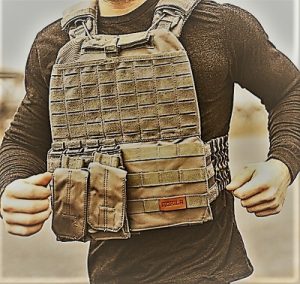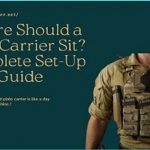How tight should a plate carrier be? While this sounds easy to answer, there’s more to it than you might think! Too much room in your plate carrier might leave room for your plates to move. Too little could result in them cutting into your body uncomfortably or falling out entirely since we want our plate carriers to be as comfortable as possible while still being effective.
This guide provides an overview of how tight you should adjust your plate carrier and what factors to consider.
How tight should a plate carrier be? | Complete Guide
Your plate carrier should fit comfortably and not restrict your movement. There are several ways to tell if it’s too loose or tight. If you can fit more than two fingers between your neck and your plate carrier, then it’s probably too loose. If there is no room between your neck and your vest, then it’s probably too tight. It shouldn’t feel like someone is choking you or your breathing is restricted.
How tight should a plate carrier be? Finding the Right Fit
Snug but Not Restrictive
Achieving the right balance is key – your plate carrier should be snug enough to stay in place during dynamic movements but not so tight that it restricts your breathing or hinders mobility.

Ensuring Proper Coverage
Front and Back Plates
Check that both the front and back plates are positioned correctly. The plates should cover vital organs without leaving exposed areas.
Side Plates
If your plate carrier accommodates side plates, ensure they are correctly positioned to provide comprehensive protection. Adjust as needed for a comfortable fit.
Comfort and Mobility
Importance of Comfort in a Plate Carrier
Comfort is not a luxury but a necessity. A comfortable plate carrier encourages extended wear without causing discomfort, making it more likely that you’ll keep it on when it matters most.

Balancing Comfort and Mobility
While comfort is crucial, finding a balance with mobility is equally important. Test your range of motion with the plate carrier on to ensure it doesn’t impede your ability to perform essential tasks.
Testing Movement with the Plate Carrier On
Before finalizing your fit, perform a range of movements, including bending, crouching, and reaching. This ensures that the plate carrier accommodates your body’s natural motions.
Security and Stability
Securing the Plate Carrier in Place
Double-check that all straps are appropriately tightened. Loose straps can lead to shifting, affecting the overall stability of the plate carrier.
Perform a brief assessment to ensure there is no unwanted movement. Your plate carrier should stay securely in place during various activities.
Ensuring Stability During Various Activities
Consider the specific activities you’ll be engaging in while wearing the plate carrier. Adjustments may be necessary based on whether you’re walking, running, or engaging in more complex maneuvers.
Common Mistakes to Avoid
Over-Tightening
While a snug fit is crucial, over-tightening can lead to discomfort and restriction of movement. Find the right balance to ensure both comfort and security.
Neglecting Proper Plate Placement
Improper placement of plates can leave vulnerable areas exposed. Take the time to position the plates correctly for maximum coverage.
Ignoring Body Type Differences
Individuals have different body types, and plate carriers should accommodate these differences. Consider your unique body shape when selecting and adjusting your plate carrier.
Maintenance and Care
Cleaning the Plate Carrier
Regular cleaning is essential to remove dirt, sweat, and other contaminants. Follow manufacturer guidelines for cleaning to maintain the integrity of the carrier.
Inspecting for Wear and Tear
Periodically inspect your plate carrier for signs of wear and tear. Replace any damaged components promptly to ensure continued effectiveness.
Regular Adjustments for Changing Needs
As your body changes or your activities vary, make necessary adjustments to your plate carrier. A proper fit is an ongoing process.
Customization Options
Adding Pouches and Accessories
Customizing your plate carrier with pouches and accessories enhances its functionality. However, ensure that added elements do not compromise the fit or comfort.
Modifying for Specific Uses
Some users may need to modify their plate carriers for specific purposes. Seek professional guidance to ensure modifications do not compromise safety.
Balancing Customization with Functionality
While customization is appealing, strike a balance to maintain the core functionality of the plate carrier. Prioritize features that enhance performance without sacrificing the fit.
Expert Tips and Recommendations of How Tight should a Plate Carrier be:
Insights from Experienced Users
Learn from the experiences of those who have used plate carriers extensively. Their insights can provide valuable guidance in achieving the perfect fit.
Advice from Professionals in the Field
Consult with professionals in the military, law enforcement, or other relevant fields. Their expertise can offer valuable perspectives on selecting and adjusting plate carriers.
Staying Updated on Industry Standards
As technology evolves, so do industry standards for plate carriers. Stay informed about the latest advancements to make educated decisions regarding your gear.
FAQs about How tight should a plate carrier be?
How do I measure myself for a plate carrier?
Measuring your chest circumference and torso length accurately is key. Refer to the manufacturer’s sizing guide for precise measurements.
Can a plate carrier be too tight?
Yes, over-tightening can lead to discomfort and restricted movement. Find the right balance for a snug yet comfortable fit.
Are there specific plate carriers for different body types?
Plate carriers come in various sizes and designs to accommodate different body types. Choose one that aligns with your unique measurements.
How often should I adjust my plate carrier?
Regular adjustments are recommended, especially if your body undergoes changes or if you switch activities. Check the fit periodically for optimal performance.
What accessories enhance the functionality of a plate carrier?
Pouches, holsters, and additional storage options can enhance functionality. However, prioritize accessories that don’t compromise the fit or comfort of the plate carrier.



![What Color Plate Carrier Should I Get? [2024 Ultimate Guide] What Color Plate Carrier Should I Get](https://theplatecarrier.net/wp-content/uploads/2022/08/What-Color-Plate-Carrier-Should-I-Get-150x150.jpg)

